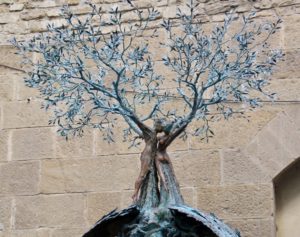Remembering the Georgofili Victims 30 Years On

SUNSET
The afternoon is on its way
The sunset is approaching
– a moment of wonder
The sun is heading to bed
It is already night, all is finished
TRAMONTO
Il pomeriggio se ne va
il tramonto si avvicina
un momento stupendo
Il sole sta andando via (a letto)
È già sera tutto è finito
Written only a few days before her death, these are the words of a nine year old girl who tragically lost her life in the fatal 1993 Georgofili blast. Thirty years on, it is no less chilling to read, and for the past three decades, ‘Tramonto,’ the title of the poem, has been the code name for the capture of Matteo Messina Denaro, one of the criminals responsible for the explosion. He was only caught this year, and the handwritten, original poem was placed in his cell – a poignant and condemning reminder of the young life he and the other offenders took away.
Notable public figures will be attending the commemorative events, including President Sergio Mattarella. On May 26, the exhibition ‘The Massacre of Via dei Georgofili: A Story Spanning Thirty Years,’ displaying the family archives of the blast’s victims, will open at the Palazzo Strozzi. In the afternoon, at Cinema La Compagnia (via Cavour 50/r), the lawyer and spokesperson for the victims’ association, Danilo Ammannato, and anti-mafia prosecutor and former president of the Italian Senate, Pietro Grasso, will be holding a discussion on the important values of justice, memory and truth.
A commemorative performance will take place outside of Palazzo Vecchio later that evening, at 9 pm, and will include the musical show, ‘The True Story of Mack the Knife’ (a murder ballad by German composer, Kurt Weill); a reading of the Mario Luzi’s poem, ‘Sia Detto’ (‘Let it be said’), a reflection on the bomb blast and its effects on the city’s psyche; and a performance of Azzurra Agostino’s ‘Quello che non so’ (‘What I do not know’). At 12.30 am, attendants will join a silent procession through Via dei Georgofili and a laurel wreath will be laid at the site of the blast at 1.04 am, the exact time of the explosion.
Planted in a stolen van, the bomb exploded in the early hours of May 27 on Via dei Georgofili, near to Torre dei Pulci, killing five innocent bystanders, including the nine-year-old girl and a baby, and injuring another 60. Additionally, the Uffizi, Palazzo Vecchio and the Church of Santo Stefano al Ponte all suffered serious damage to their architecture, artworks and furnishings. At the Uffizi alone, three minor paintings were completely obliterated, whilst another 200 were badly affected, including the iconic Adoration of the Shepherds by Baroque artist Gerardo delle Notti (1592 – 1656).
A judicial enquiry into the event revealed that the Sicilian mafia was responsible for the attack. But this was no stand-alone tragedy. The devastating event occurred at a time of widespread unrest within the criminal network, which was responding to the State’s crackdown and strict prison regimes (namely, the implementation of solitary confinement, Article 41-bis) with terror and destruction. Cultural heritage sites across Italy became the common targets, and Florence, perhaps inevitably, got caught in the crossfire.
Whilst the incident represents cold-blooded disregard for human life and cultural heritage, Florence has dusted itself down over the years and hosted numerous initiatives in response to the tragedy, proving the power and role of art as a recuperative force in society. In Eike Schmidt’s words, the director of the Uffizi, ‘art is a tangible sign that civilisation cannot be erased with bombs’.
EXHIBITIONS
‘The Massacre Season, 1993: the Bombs of Florence, Rome and Milan’ by the artist Gianluca Braccini and curated by Arianna Canalicchio [Carriage Gallery of Palazzo Medici Riccardi, through May 28]
‘May 27, 1993’ by Luciano Guarnieri, a display of photographic and watercolour works relating to the blast [Georgofili Academy, through June 15, FREE ADMISSION]
‘Tree of Life’ by Andrea Roggi, an exhibition on the story of a memorial bronze sculpture erected on the spot where the bomb detonated, [Palazzo Vecchio, from May 20 – 27]
‘Risarcimento’, an exhibition curated at the time of the blast, comprising works of art from around the world that were donated by artists to relieve the Uffizi of its loss, [Uffizi, from May 23 – June 18]
Further information about readings and conferences can be found by following the link below: https://www.comune.fi.it/30%C2%B0-strage-di-via-dei-georgofili
(Sophie Holloway)
